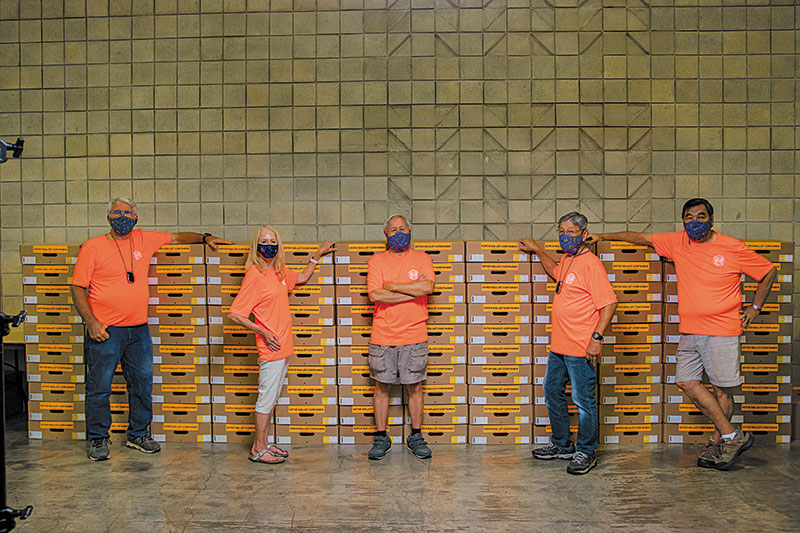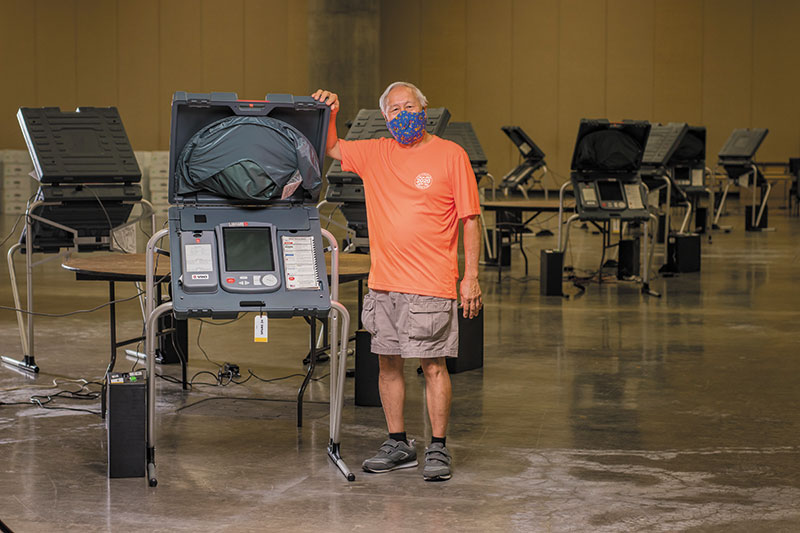Vote of Confidence

Official Observers (from left) Michael Kerr, Peggy Regentine, Dennis Kam, Kenyon Wong and Yasuhiro Takeno are among the dozens of volunteers who are helping to make the 2020 election safe and efficient.
Even before the Nov. 3 general election, serious-minded volunteers known as Official Observers have been doing their part by ensuring a veracious voting process.
Election season is in full swing, and many around the state have already started sending in their mail-in ballots ahead of Nov. 3. Behind the scenes of the general election, there are hundreds of volunteers giving their time to ensure each person’s voice is heard and that the voting process remains smooth, safe and secure.
Among these volunteers are the Official Observers, who have been hard at work testing counting machines to be certain they’re functioning correctly. They’ve also been taking part in the signature verification process for mail-in voting. As ballots come pouring in, they’ll oversee the handling of these votes, too.

Dennis Kam stands next to voting equipment that Official Observers have tested at Hawai‘i Convention Center.
“We’re the public’s eyes and ears,” shares Official Observer chairperson Dennis Kam.
The group — independent of the Office of Elections — is made up of volunteers from all community sectors. Many come from different political parties and organizations such as League of Women Voters and Chamber of Commerce Hawai‘i, but their goal is the same: to guarantee that every vote is counted and that the election process has integrity.
For his part, Kam has been involved with bolstering Hawai‘i’s election process since 1982 (when he was the media representative on the election advisory committee) and he’s witnessed how the process has changed over the years.
“I started when they still had the old IBM punch cards,” he recalls with a laugh.
Technology has grown by leaps and bounds in the decades since, as has the ability to ensure an accurate count. This go-around, for example, voters can track their ballots by visiting elections.hawaii.gov.

There’s also controlled access to and from the counting center, and tamper-proof seals are recorded, signed and placed on locked ballot boxes for security purposes.
Once it comes time to handle the ballots, all counting center operations take place in the presence of a group of Official Observers.
Ballots are prepared for counting in a controlled way: Return envelopes are opened and their secrecy sleeves, which contain the ballot, are removed. As an added precaution to ensure privacy, return envelopes are placed face down so the voter’s name and address are not visible. If there are ballots that are unable to be counted because of damage or other reasons, they are duplicated, certified by Official Observers and marked with a control number so that they can be traced back to the original ballot.
“Whenever there’s a ballot laying on the table, we’re there,” Kam assures. “There are lots of checks and balances, so many audit trails. There’s a check for this and a check for that.”
He even notes that no blue or black pens are allowed anywhere on the counting floor because those are the required colors for filling out a ballot. Rather, Office of Elections staffers use red pens, and Official Observers use green pens.
After the election, the work continues for Official Observers. They do one final counting machine test after all the ballots have been read to make sure the data exactly mirrors the output from the test prior to the election. Furthermore, each County Elections Division is responsible for reconciling the number of ballots received with the number of ballots counted.
If it seems like a lot of work, it is, and, it’s indicative of how seriously election workers take their jobs.
“We put in a lot of hours,” Kam adds. “It’s a public service for the community. And we welcome new faces, too.”
Official Observers are doing their part to keep the voting process going in an era of constant change, especially with voting by mail being the preferred method this year. In fact, chief election officer Scott Nago relays that 99 percent of votes cast in Hawai‘i’s 2020 primary were by mail, and more than 50 percent of registered voters submitted their ballots.
“That’s high for a primary, ” he says. “In 2018, we had only 38 percent.”
He’s hoping for an even bigger turnout for the general election Nov. 3. Voters concerned about mailing in their ballots have the option of dropping them off in-person at one of a dozen Places of Deposit on O‘ahu (see story at right). No matter the method of submitting one’s ballot, though, the Hawai‘i elections team has a simple message:
“Cast your vote,” Kam urges. “You’re electing people who will decide how to spend your money. If you want a say as to how your money is spent, vote for the person best suited for that purpose.”
Registered voters should have received their ballots in the mail. Those who haven’t received their ballot by Oct. 16 should contact their County Elections Division. Mail-in ballots must be received by election day, Nov.3. Nago recommends mailing ballots back at least by Oct. 27.
Details on the voting process can be found online at elections.hawaii.gov or honolulu.gov/elections.
Voter Service Centers
Kapolei and Honolulu Hales serve as Voter Service Centers and offer accessible voting, same-day voter registration and in-person voting. Voter Service Centers are open Mondays-Saturdays from 8 a.m. to 4:30 p.m. (Oct. 20-Nov. 2), and 7 a.m.-7 p.m. Nov. 3.
Visit elections.hawaii.gov for more information.
Places of Deposit
The Office of Elections recommends returning your completed ballot by mail by Oct. 27. Those that miss this date can drop off their ballots to the place of deposit nearest them. Hours are in daily accordance with park hours Oct. 6-Nov. 2, and until 7 p.m. on election day, Nov. 3. Kapolei and Honolulu Hales have different hours.
Visit elections.hawaii.gov for the schedule.
Kahuku Community Center and District Park
56-170 Pualalea St.
Kailua District Park
21 S. Kainalu Drive
Kāne‘ohe District Park
45-660 Kea‘ahala Road
Hawai‘i Kai Park and Ride
240 Keāhole St.
Kānewai Community Park
2695 Dole St.
Kalihi Valley District Park
1911 Kamehameha IV Road
Neal S. Blaisdell Park
98-319 Kamehameha Hwy.
Bill Balfour Jr. Waipahu District Park
94-230 Paiwa St.
Mililani Park and Ride
95-1101 Ukuwai St.
Wai‘anae District Park
85-601 Farrington Hwy.
Kapolei Hale
1000 Uluohia St.
Honolulu Hale
530 S. King St.






